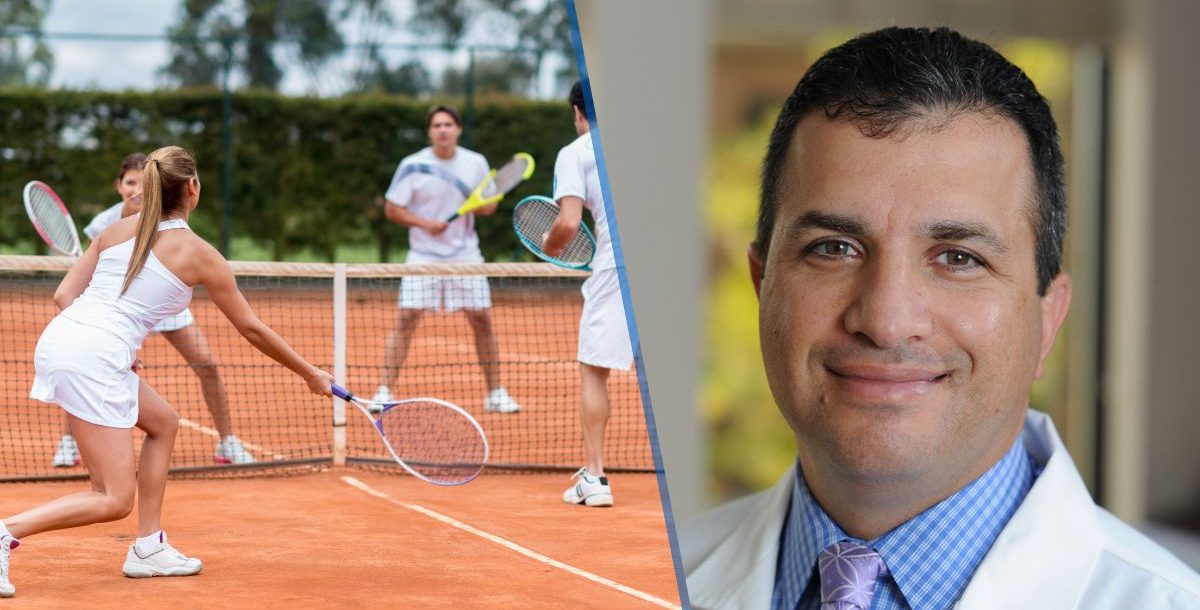Before picking up a racquet, understanding common tennis injuries can help you work to prevent sustaining them when you play.
Benefits of playing tennis
The advantages of playing tennis go well beyond improving hand-eye coordination, strengthening muscles and increasing overall aerobic capacity. Playing tennis regularly, even at a recreational level, can also improve brain function, reduce stress and provide a social outlet, regardless of age.
Mercy Health orthopedic surgeon Samer Hasan, MD, PhD, personally knows the benefits of tennis. Dr. Hasan first picked up a racquet at the age of 8 and continues to play a couple of times a week. He is also the chief medical officer for the 2025 Cincinnati Open tennis tournament. Dr. Hasan explains some of the common tennis injuries that players can sustain, regardless of their skill or experience.
If you notice you have symptoms associated with one or more of these common tennis injuries, make an appointment with an orthopedic specialist.
Common tennis injuries
Because tennis involves a lot of repetitive motions, overuse injuries often occur. Here’s what you need to know about several common tennis injuries that develop from overuse.
Tennis elbow
Formally called lateral epicondylitis, a form of chronic tendinitis, tennis elbow is the degeneration of the extensor tendons that connect a group of forearm muscles to the outside of your elbow.
Because this muscle is used most when the ball hits the tennis racquet, players often develop tennis elbow from overuse. If you have it, you’ll likely notice pain on the outside of your elbow, especially when straightening the elbow, as well as weakened grip strength.
Golfer’s elbow
Medial epicondylitis, more informally referred to as golfer’s elbow, is another form of tendinitis that tennis players can develop. Despite its more colloquial name, golfer’s elbow is not limited to just those playing golf.
Golfer’s elbow refers to the degeneration of the flexor tendons that connect a group of forearm muscles to the inside of your elbow. Tennis players can develop this condition from overuse of backhand strokes or generating a lot of topspin.
Common symptoms include pain in the inner elbow/forearm, weakened grip strength and numbness/tingling, typically limited to the ring and little fingers.
Rotator cuff injuries
Common tennis injuries often involve your rotator cuff. Your rotator cuff is a group of four muscles and tendons that help stabilize your shoulder. When these rotator cuff muscles and tendons are fatigued or weak, they get irritated and cause inflammation.
Some common rotator cuff injuries include:
- Rotator cuff tendinitis
- Rotator cuff bursitis
- Rotator cuff tear
Rotator cuff tendons can tear as a result of sudden trauma, resulting in pain and weakness. However, more commonly, rotator cuff tears occur slowly over time. This is due to overuse – your overhead serve can be taxing on your rotator cuff tendons.
Players dealing with a rotator cuff injury usually notice shoulder pain, weakness and difficulty or inability to achieve a full range of shoulder motion. They often have trouble generating power with their serves or overheads.
Stress fractures
You can develop a stress fracture many ways. However, several are more common for those who play tennis, including:
- Back stress fracture
- Tibia or fibula stress fractures
- Navicular or metatarsal stress fracture
A stress fracture is a tiny, hairline crack in your bones or vertebrae. When your muscles get tired, more stress is placed on your bones. If this happens rapidly, your bone might not be able to adjust quickly enough to accommodate the stress, causing a fracture. This exhaustion is why stress fractures often result from overuse, especially as a result of increasing your training too quickly.
Symptoms of a stress fracture include pain, tenderness and swelling that might get worse over time, but often fade with rest.
Muscle strains and sprains
Any muscle can sustain a strain or sprain, but some are more common for tennis players. Some of these include:
- Wrist strain
- Knee strain
- Shoulder sprain
- Ankle sprain
Strains and sprains in your muscles are caused by stretching out or damaging ligaments around a joint. They’re usually caused by quick, sudden moves from changing directions or reacting to your opponent’s shot
Symptoms to pay attention to are pain, stiffness and swelling, instability in the affected joint and bruising.
Ways to prevent common tennis injuries
Decrease the likelihood of experiencing these overuse injuries with proper preparation. Dr. Hasan says that making time for the warm-up ahead of starting play is critical to avoiding injury.
“Don’t hit the court cold,” he says. “Rapid movements without preparation can lead to injury.”
Here are a few tips to help you play tennis safely:
- Strengthen your muscles: This includes not only the muscles you’re directly using, but those around them, too. Dr. Hasan says serving the ball isn’t just about working your shoulder and arm – your thighs, back and core are all incredibly important to produce the energy needed to generate a powerful first serve.
- Build upon your endurance training: It’s important to ease into the sport and not overextend yourself.
- Warm-ups and stretching: Dr. Hasan suggests doing these for at least 10 to 15 minutes before playing. Your warm-up could include some aerobic exercises like a slow jog or jumping jacks. For stretches, hold them for 30 seconds or longer and don’t bounce. Moving, swinging stretches are also helpful to get you ready to play.
- Cool down: Give yourself at least five minutes to cool down and stretch after playing.
- Make sure you have the right equipment:
- Shoes: Your tennis shoes should fit comfortably and provide good arch support to help prevent ankle injuries or stress fractures in your leg and foot.
- Socks: Wear socks for extra cushioning. Change them frequently to stay comfortable on the court and prevent blisters.
- Racquet: Dr. Hasan adds that a proper racquet for you is necessary to avoid injury as well. Your racquet should fit your hand comfortably, with the correct grip, size, weight and string tension to reduce stress on your wrist, elbow and shoulder.
- Develop healthy habits: Take breaks and drink plenty of water or sports drinks to stay hydrated
- Inspect the courts: Clean up or dry any slick or slippery spots and remove any debris before playing.
How we can help
If you develop any common tennis injuries, the first line of treatment is to rest, ice, apply compression and elevate the injury. Anti-inflammatory medication or strengthening exercises can also help.
However, if these don’t help your injury, make an appointment with an orthopedic specialist or a sports medicine doctor. They can order imaging and diagnose your condition in order to provide you with a personalized treatment plan that can help you get back onto the court.
Learn more about the orthopedic and sports medicine services we offer at Mercy Health.






